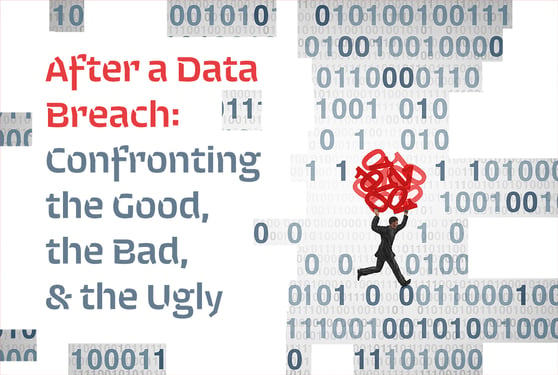After a Data Breach: Confronting the Good, the Bad, and the Ugly
Every business is at risk of being breached. The constant state of vulnerability can be terrifying, but the reality of a security breach can be outright catastrophic.
breach can be outright catastrophic.
A report by IBM evaluates the average cost of a cyber breach to be around $4.45 million, and the breach can devastate business operations, customer security, and even your workforce, depending on the type of attack.
Regrettably, the majority of organizations across various sectors still have significant work ahead of them to safeguard their assets from evolving threats and cyberattacks. Though the dangers are swiftly growing in number and severity, taking steps to be more resilient and agile in the face of disruptive and damaging cyberattacks can help dramatically reduce their impact on your operations - from IT and financial to customer-facing.
This journey to becoming more cyber-resilient starts with taking practical, pragmatic steps to recover from a breach, so let’s briefly review these essentials:
Containment
Once you’ve identified that an incident is underway, your primary focus in containing a data breach should be on expelling active intruders and halting any further unauthorized access. This objective can be met by isolating the impacted device, systems, or network. In situations where the breach is localized to a specific device, such as a server or workstation, disconnect it from the network by detaching the network cable or, if it’s a wireless connection, by deactivating the wireless access. If you observe active processes running on the affected system, make an effort to terminate those processes.
It is recommended to maintain a duplicate immutable system backup as a means to facilitate the recovery of business operations, thereby preventing the permanent loss of any compromised data. This presents an opportunity to revise and improve your system, assess your remote access procedures (enforcing compulsory multi-factor authentication), update all user and administrative access credentials, and fortify password security measures.
Assessing Impact
After you’ve effectively contained or secured the breach, the next stage should involve a detailed evaluation of its impact. It’s like peeling away the layers to uncover the full picture. 
To start off, you need to evaluate the scale of the breach. This includes quantifying the systems, users, data, backups, and devices ensnared in the event. Is the breach localized to a particular department, location, or system, or does it extend to broader ramifications? Additionally, you will need to categorize the compromised data based on its sensitivity level, prioritizing response actions based on the potential harm that could result from its exposure. Has your data, including backups, been encrypted? Has it been exfiltrated? Have you received ransomware demands?
Whether you have an in-house security team at your disposal or require the services of external investigators, it is crucial to pause and assess both your data assets and the potential risks they face. Additionally, it’s important to identify the types of attacks that pose the greatest vulnerability, anticipate the potential objectives of an attack, and conduct simulations collaboratively as a team. To achieve these goals, it’s crucial to view things from a business standpoint and ensure that your security strategies are in line with your organization’s approach to managing risks.
If a cybercrime has a significant impact, report it to both the FBI and CISA. Share detailed information about the incident, its effects, affected systems, and any indicators of compromise you’ve found. Cooperate fully with their agents, which may require sharing data and logs to aid the investigation.
Notification/Communications
Confronting a data breach in real-time, without a predefined crisis management plan, can be an overwhelming experience. That’s why it’s essential for every strategic plan and a company’s overarching security strategy to include a systematic data breach communication plan. Here are some measures you should consider beforehand:
-
- Handpick the members for your organization’s crisis communication team, establishing their roles and explicitly outlining their authority when it comes to real-time messaging and communication.
- Evaluate the legal disclosure prerequisites and go over the potential brand consequences, taking into consideration both legal duties and public sentiment. Make a decision on whether to initiate communication with stakeholders proactively or reactively while maintaining thorough documentation of your chosen course of action.
- Figure out who your primary champions are among your customer base, partners, investors, and media analysts, as your reputation can change abruptly in the face of a cybersecurity crisis.
Lastly, determine the content and timing of your messaging. It may not always be feasible to postpone information sharing or response until all facts are established; therefore, it’s prudent to have discussions with your executive team to establish the disclosure criteria for each phase of the breach.
Remediation
Remediation refers to limiting the damage a data breach can cause to a business. It involves eliminating suspicious activities and malicious attacks in the form of malware, ransomware, and phishing. For instance, if a data breach occurs, it’s essential to promptly disconnect all impacted devices from the network. However, refrain from shutting down any machines until the forensic experts arrive. Make sure to oversee all entry and exit points, particularly those associated with the breach.
In the event of a data breach where personal information was incorrectly displayed on your website, promptly remove this data. And, if you haven’t already addressed this during the containment phase, assess and update access controls and permissions to guarantee that only authorized individuals can access sensitive data and systems. Once you receive the forensic reports, swiftly implement the recommended corrective actions, bearing in mind that these measures can differ from one breach to another.
As of today, many remediation tactics are basically temporary fixes that don’t account for long-term consequences. Even if you manage to neutralize the suspicious activity, intruders may persist deep within your systems. To achieve a comprehensive solution, you need to pinpoint the core issue, and this can take a while.
 Recovery
Recovery
Once the threat has been mitigated or completely ended, you can focus on restoration and recovery.
What steps do you need to take to restore your systems back to normal, and what’s the fastest and most efficient way to do this?
Well, keep in mind that data backups are a fundamental aspect of cybersecurity disaster recovery. With all your data archived in a separate location, you gain the ability to reinstate your systems regardless of the threats at hand, whether it’s ransomware attacks, DDoS attacks, or complete data corruption. This guarantees recovery of previous iterations of your company’s vital assets, and you can somewhat steer clear of long-lasting damage.
Consider tracking recovery metrics through pre-existing protocols. Ask questions like:
-
- How quickly did you respond upon identifying the threat?
- How long did it take to restore business operations to normalcy?
If recovery appears to be beyond reach, bring in professionals with the necessary skills to clean the system. Entrusting untrained team members with this task may pave the way for future security vulnerabilities.
And then, after your system has been rebuilt, ensure that all systems are up to date with patches. It will take a significant amount of time, but it’s advisable to inspect the data if any storage areas were compromised. It’s also vital to guarantee the database is clean, which could involve going back to an immutable backup, examining the data, and using transaction logs to rebuild your server.
Lessons Learned
Cyber threats will continue to plague businesses; it’s inevitable. Hence, all you can do is learn from past data breaches, work to reduce susceptibility, fortify security readiness, and foster future cyber resilience. Notably, these insights stress the importance of orchestrating a multi-layered cybersecurity strategy that centers on policy, technology, and people.
To thwart future data breaches, organizations can take proactive steps by using a comprehensive approach. This includes implementing Zero Trust solutions, which involve continuously verifying and authenticating all users and devices. Additionally, organizations should employ micro-segmentation to restrict lateral movement within their network and adhere to the principle of least privilege access. These measures collectively strengthen cybersecurity defenses. Application Security Testing methods can also be deployed to identify and mitigate vulnerabilities in software.
Imagine security awareness training as the keystone in building a culture of cyber responsibility. In a landscape where cyber adversaries aim to sway employees like puppeteers, granting access to valuable data and systems, organizations can bolster their defenses by arming their teams with the ability to spot and deflect cyber threats.
For added security, you should set up guidelines for how employees access company data and utilize organizational IT resources. These policies must be consistently upheld to achieve the best results in protecting company systems and valuable data.
In the face of the escalating threat of cyberattacks, leaders at the helm must take an active role in cybersecurity, leading by example and steering their workforce toward robust cybersecurity practices. Moreover, it’s critical to develop a disaster recovery and business continuity plan and be ready to act swiftly and decisively in the event of an attack. This plan should stand tall at the forefront of your cybersecurity agenda, ensuring resilience and a smooth course of action amid the cybersecurity landscape.
To learn more about building your company’s cybersecurity strategy and making improvements for the future, learn about GSI’s comprehensive cybersecurity solutions and services. Feel free to contact us today to get started.
